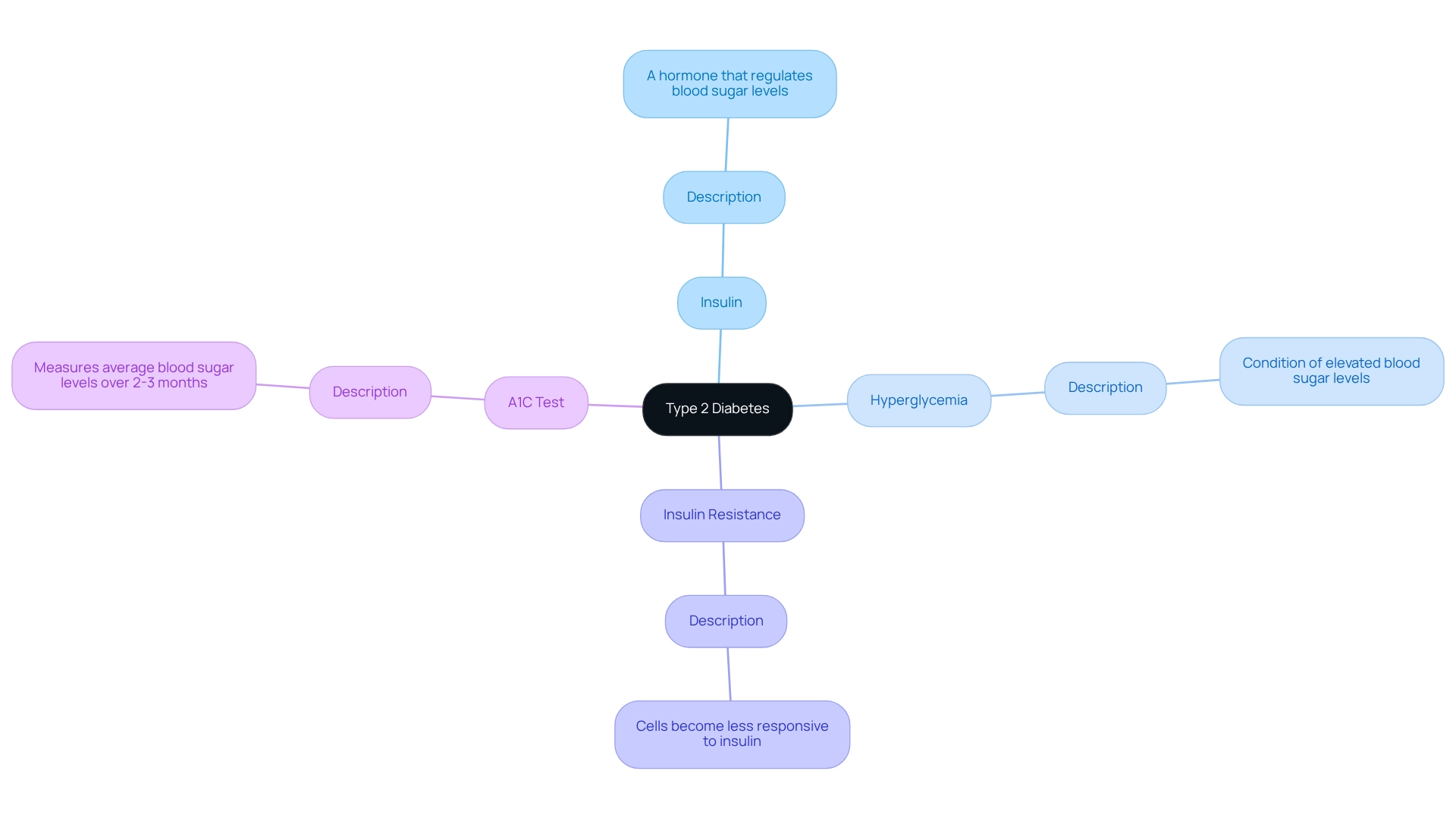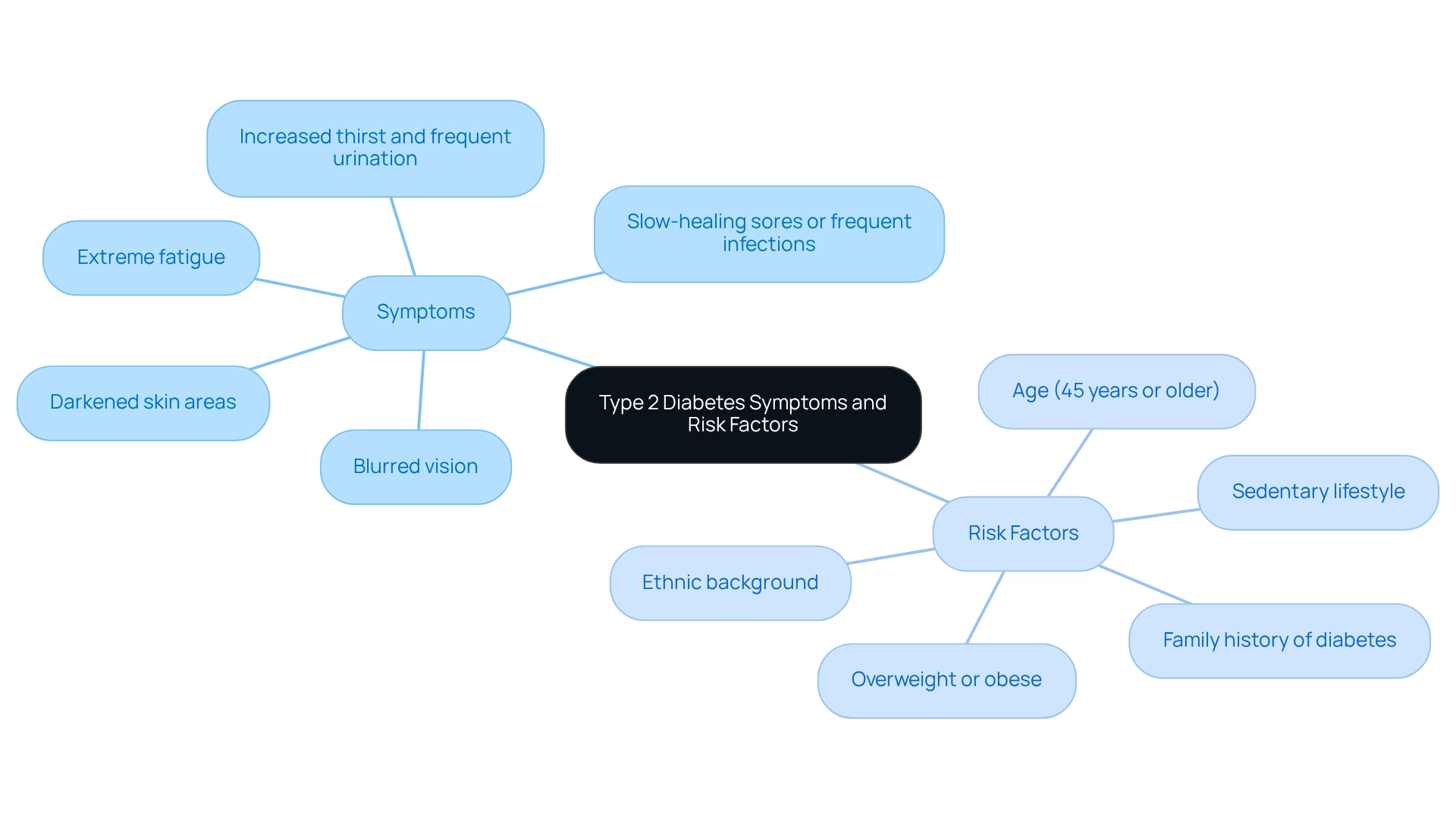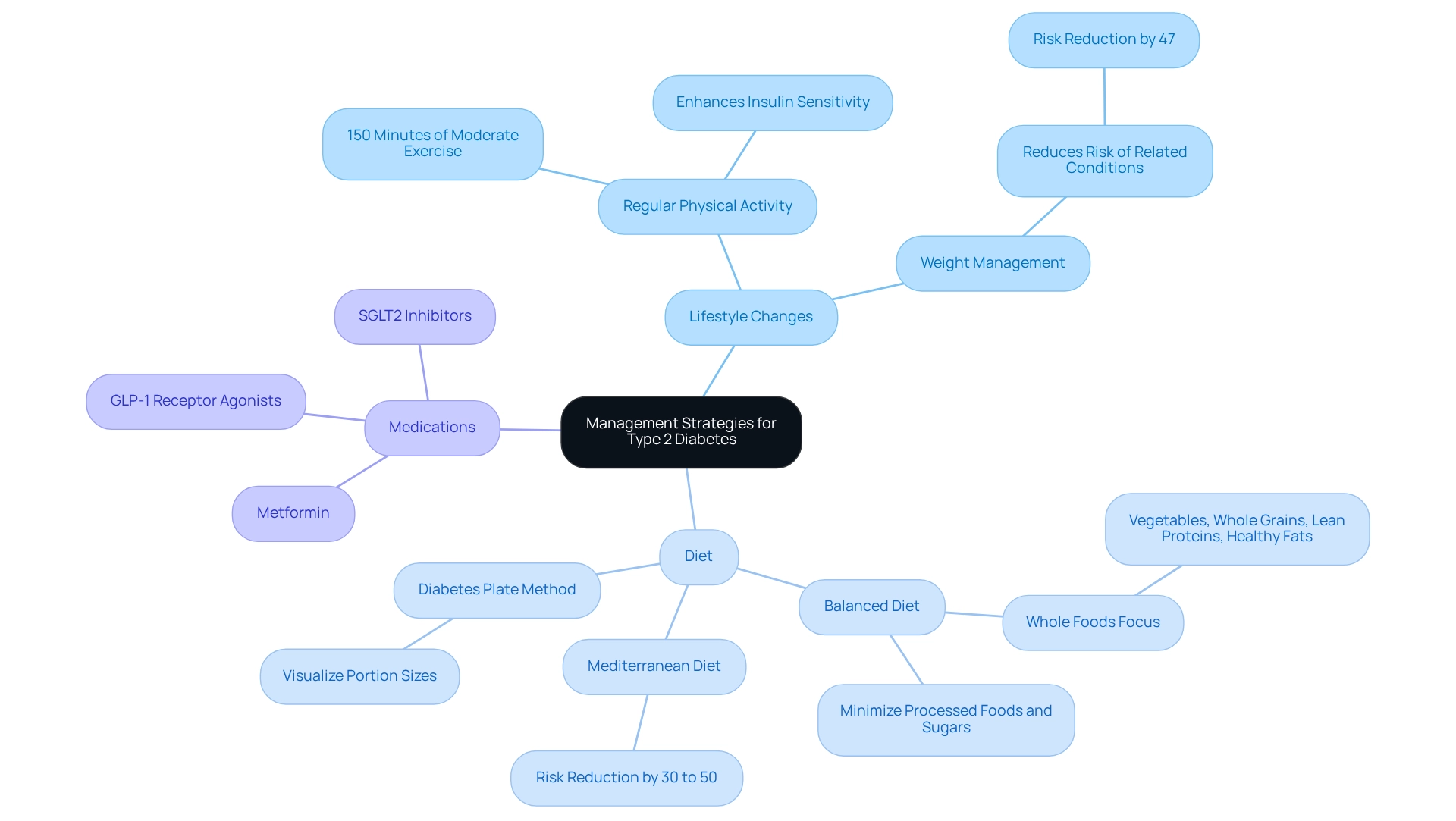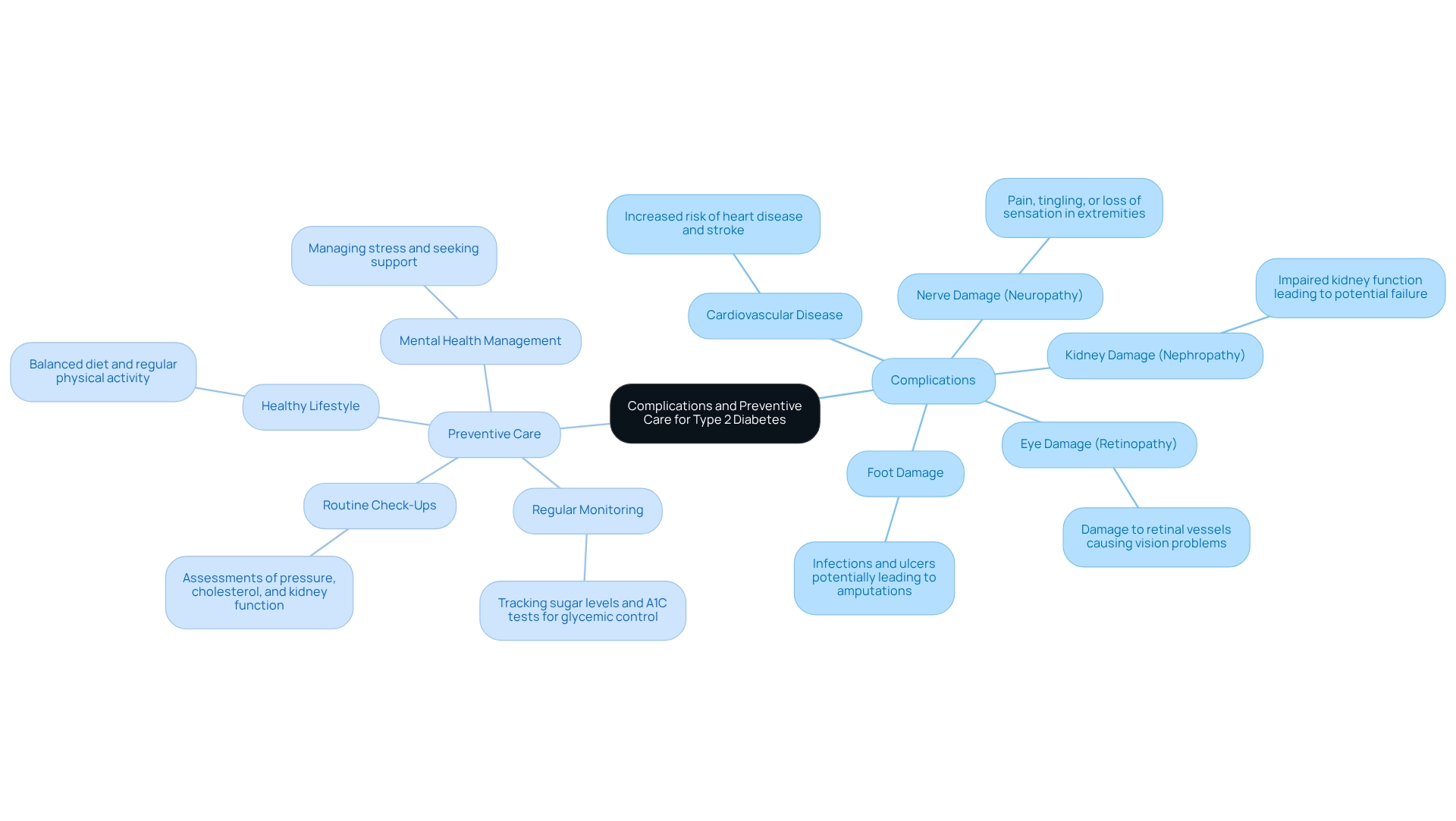Overview
Type 2 diabetes can feel overwhelming, especially as it is characterized by insulin resistance, which leads to elevated blood glucose levels. It's increasingly being diagnosed among diverse populations, including adolescents. Understanding this condition is crucial. By recognizing key concepts, symptoms, and risk factors, you can take proactive steps toward your health.
Undergoing appropriate diagnostic tests and implementing effective management strategies empowers you to take control of your well-being. Remember, you're not alone in this journey. Together, we can navigate these challenges, ensuring you have the support and resources you need.
Introduction
In a world where chronic conditions are increasingly prevalent, Type 2 Diabetes emerges as a significant health challenge, impacting millions around the globe. This complex disease, marked by insulin resistance and elevated blood glucose levels, calls for a multifaceted understanding to ensure effective management and prevention. It's understandable to feel overwhelmed, but recognizing symptoms and risk factors is the first step toward taking control. Navigating the diagnosis process and implementing lifestyle changes can empower you to combat this condition with confidence.
The potential complications of unmanaged diabetes underscore the urgency for proactive care and community support. Remember, you're not alone in this journey. As research evolves and awareness grows, the importance of education and resources becomes paramount. We are here to support you every step of the way, helping you lead a healthier life and fostering a sense of community among those affected by Type 2 Diabetes.
Define Type 2 Diabetes: Key Concepts and Terminology
Understanding type 2 diabetes can feel overwhelming, but you're not alone in this journey. This long-lasting condition is marked by insulin resistance, where the body struggles to use insulin efficiently, leading to increased glucose levels. Knowing key terms can empower you in your conversations with healthcare providers and help you manage your condition effectively. Here are some important concepts to consider:
- Insulin: A hormone produced by the pancreas that regulates blood sugar levels.
- Hyperglycemia: A condition characterized by elevated blood sugar levels, which, if not managed properly, can lead to serious health complications.
- Insulin Resistance: A state where the body's cells become less responsive to insulin, requiring higher insulin levels to achieve the same effect.
- A1C Test: A blood test that measures average blood sugar levels over the past 2-3 months, essential for diagnosing and monitoring diabetes.
It's important to acknowledge that current statistics show the prevalence of type 2 diabetes among Hispanic, Latino, or Spanish adults ranges from 5.0% to 7.3%. In 2020, there were 267,000 emergency department visits for hyperglycemic crises among adults with diabetes, highlighting the urgent need for improved diabetes management and education. As the Centers for Disease Control and Prevention (CDC) notes, type 2 diabetes is increasingly being diagnosed around puberty, underscoring the significance of early awareness and intervention.
For those of you taking metformin, remember that consulting with healthcare providers about medication management is crucial. As research continues to evolve, understanding insulin resistance and its impact on type 2 diabetes remains essential for effective treatment and prevention strategies. We are here to support you every step of the way as you navigate this journey.

Identify Symptoms and Risk Factors of Type 2 Diabetes
Common symptoms of Type 2 Diabetes include:
- Increased thirst and frequent urination
- Extreme fatigue
- Blurred vision
- Slow-healing sores or frequent infections
- Areas of darkened skin, typically found in the armpits and neck.
Recognizing these symptoms is crucial. It’s understandable to feel overwhelmed, but acknowledging these signs can prompt you to seek information and medical advice sooner. This proactive approach can lead to an earlier diagnosis and more effective management.
Risk factors for developing Type 2 Diabetes encompass:
- Being overweight or obese
- A sedentary lifestyle
- Family history of diabetes
- Age (45 years or older)
- Ethnic background, with higher prevalence observed in certain groups.
Statistics indicate that from 2012 to 2022, the additional medical expenses per individual linked to the condition rose from $10,179 to $12,022. This emphasizes the financial strain that Type 2 Diabetes can impose. Furthermore, individuals with this condition are twice as likely to experience depression compared to those without, underscoring the need for comprehensive support systems.
Recent studies indicate that Type 2 Diabetes is increasingly diagnosed around puberty, affecting various ethnic groups. As noted by the Centers for Disease Control and Prevention (CDC), "Across all ethnic groups though, type 2 blood sugar issues are increasing around the age of puberty." Real-life examples demonstrate that lifestyle changes, such as improved diet and increased physical activity, can significantly reduce the risk of developing Type 2 Diabetes. For instance, individuals who embraced a balanced diet and participated in regular exercise reported significant enhancements in their health and a lowered risk of developing diabetes-related issues.
At T2DSolutions, we emphasize the importance of community support. You’re not alone in this journey. We encourage individuals to share their experiences and connect with others facing similar challenges. This collaborative method not only boosts motivation but also offers emotional support, leading to improved management results.
Stay tuned for more comprehensive resources and community support options that will be available soon through T2DSolutions.

Explain the Diagnosis Process: Tests and Criteria for Type 2 Diabetes
Diagnosing Type 2 Diabetes involves several key tests that provide critical insights into a person's sugar levels. At T2DSolutions, we are here to assist newly diagnosed patients by offering vital information and resources for effective management of their condition.
- Fasting Plasma Glucose (FPG): This test assesses sugar levels after fasting for a minimum of 8 hours. A result of 126 mg/dL or greater signifies the condition, making it a fundamental diagnostic tool.
- A1C Test: The A1C test indicates average sugar levels over the past two to three months. An A1C level of 6.5% or greater indicates the presence of this condition, emphasizing its importance in long-term glucose monitoring. Recent statistics indicate that approximately 70% of patients are diagnosed using the A1C test, underscoring its significance in clinical practice.
- Oral Glucose Tolerance Test (OGTT): This test assesses blood sugar levels before and two hours after consuming a sugary drink. A reading of 200 mg/dL or higher confirms the condition, providing a dynamic view of glucose metabolism.
- Random Plasma Glucose Test: This test can be conducted at any time, with a level of 200 mg/dL or higher suggesting the presence of the condition. It is especially helpful for diagnosing the condition in symptomatic individuals.
Understanding these tests and their results is essential for patients, as it empowers them to take an active role in their healthcare journey. Healthcare professionals play a vital role in educating patients about these tests and their implications. As M. Sue Kirkman mentions, "The role of healthcare professionals is essential in informing patients about diabetes-related issues and its complications." This ensures that individuals are well-informed about their health status and management options. Real-world examples illustrate how patients navigate the diagnosis process, emphasizing the need for clear communication and support throughout this critical phase.
For more information and assistance concerning your blood sugar management, we encourage you to explore the resources available at T2DSolutions.

Outline Management Strategies: Lifestyle, Diet, and Medications
Managing Type 2 Diabetes effectively requires a multifaceted approach that includes lifestyle changes, dietary modifications, and, when necessary, medications. At T2DSolutions, we understand how overwhelming this journey can feel, and we are here to support you every step of the way. Our resource hub offers valuable information, educational materials, and community support to aid in your diabetes management.
-
Lifestyle Changes: Engaging in regular physical activity is vital. Aiming for at least 150 minutes of moderate exercise per week can significantly enhance insulin sensitivity. Weight management also plays a crucial role in controlling blood sugar levels. Research shows that lifestyle modifications can lower the likelihood of developing related conditions by up to 47%, with a risk ratio of 0.53 (95% confidence interval of 0.41 to 0.67). This statistic underscores the importance of specific lifestyle changes, such as increased physical activity and weight management, in diabetes prevention. Remember, you're not alone in this journey; small changes can lead to significant improvements.
-
Diet: Adopting a balanced diet centered on whole foods—such as vegetables, whole grains, lean proteins, and healthy fats—while minimizing processed foods and sugars is essential. The Mediterranean diet, for example, has been demonstrated to reduce the risk of Type 2 conditions by 30% to 50%, depending on the baseline population examined. Utilizing the Diabetes Plate Method can assist in visualizing appropriate portion sizes, making it easier to adhere to dietary recommendations. It's understandable to feel confused about what to eat—taking it one meal at a time can make it feel more manageable.
-
Medications: For certain individuals, medications such as Metformin may be essential to assist in regulating sugar levels. Other options include GLP-1 receptor agonists and SGLT2 inhibitors, which can be tailored to meet individual health needs. If you're feeling uncertain about these options, know that your healthcare provider can help guide you in finding the right fit for your situation.
Regular monitoring of blood sugar levels and maintaining routine check-ups with healthcare providers are critical components of effective management of the condition. T2DSolutions is here to help you navigate these aspects of your care. Case studies employing the GRADE method have demonstrated differing degrees of evidence certainty concerning lifestyle interventions, highlighting the necessity for tailored strategies in managing Type 2 Diabetes. As Sayedah Sarah Mousavi mentioned, "Therefore, we decided to address the research question of whether lifestyle changes are more advantageous in reducing long-term health issues or whether treatment with metformin might be a better solution." By implementing these management strategies and utilizing the resources available through T2DSolutions, individuals can significantly improve their health outcomes and quality of life. Remember, every step you take is a step toward a healthier you.

Discuss Complications and Preventive Care for Type 2 Diabetes
Complications of unmanaged second form of the condition can be severe and multifaceted, and it's important to recognize them to take proactive steps toward better health. Here are some key complications to be aware of:
- Cardiovascular Disease: If you have the second form of the condition, you may be at a significantly higher risk for cardiovascular issues. Current rates indicate that this illness can increase the likelihood of heart disease and stroke, which is understandably concerning.
- Nerve Damage (Neuropathy): Elevated sugar levels can lead to nerve damage, resulting in pain, tingling, or loss of sensation, particularly in the extremities. This can be distressing, but understanding it is the first step toward management.
- Kidney Damage (Nephropathy): This illness can impair kidney function, potentially leading to kidney failure, which may require dialysis or transplantation. It's crucial to monitor kidney health closely.
- Eye Damage (Retinopathy): Unmanaged second form of the condition can cause damage to the vessels in the retina, leading to vision problems and even blindness. Regular eye check-ups can help catch issues early.
- Foot Damage: Complications such as infections and ulcers can arise, sometimes resulting in amputations if not properly managed. Taking care of your feet is essential.
To mitigate these risks, consider implementing the following preventive care strategies:
- Regular Monitoring: Consistent tracking of sugar levels and A1C tests helps in maintaining glycemic control, which is crucial for preventing complications. You're not alone in this journey; many find that regular monitoring brings peace of mind.
- Routine Check-Ups: Regular assessments of pressure, cholesterol, and kidney function are vital for early detection of potential issues. These check-ups can be a source of reassurance.
- Healthy Lifestyle: Adopting a balanced diet and engaging in regular physical activity can significantly improve overall health and reduce complications. Research has shown that suitable diet and exercise habits contribute to improved glycemic control and fewer complications, making a positive impact on your life.
- Mental Health Management: Managing stress and mental health is also essential, as psychological well-being plays a vital role in managing this condition. Remember, it's okay to seek support.
By recognizing these complications and applying effective preventive strategies, you can greatly lower your risk and improve your overall quality of life. For instance, studies have shown that tight control of elevated blood pressure in Type 2 Diabetes patients can reduce diabetes-related deaths by 32%, underscoring the importance of proactive health management. Furthermore, the Manitoba Follow-up Study shows that this condition is significantly linked to atrial fibrillation, with a relative risk of 1.82. It's also crucial to treat hyperglycemia, as it is the primary cause of serious and life-threatening complications in this condition, as noted by Anna Garmpi from the First Department of Pediatrics, Aghia Sophia Children's Hospital.
At T2DSolutions, we strive to offer a thorough resource center for type 2 diabetes information and the management of diabetes-related issues. Our platform provides valuable information, support, and community engagement for newly diagnosed patients, helping you navigate your journey with Type 2 Diabetes. Focused measures are essential to tackle the distinct difficulties encountered by minority groups, who face elevated rates of this condition and its complications. This holistic approach to diabetes care not only improves health outcomes but also fosters a supportive community for those affected. Remember, you are not alone in this journey—we are here to support you every step of the way.

Conclusion
Type 2 Diabetes is a complex condition that requires a comprehensive understanding of its mechanisms, symptoms, risk factors, and management strategies. By recognizing key concepts—such as insulin resistance, hyperglycemia, and the significance of the A1C test—you can take proactive steps toward better health. It’s crucial to be aware of the symptoms and risk factors, as early detection can lead to more effective management and improved outcomes.
The diagnosis process involves several important tests, each providing valuable information about blood sugar levels. Understanding these tests empowers you to engage actively in your healthcare journey, ensuring you receive the necessary support and education from healthcare professionals. Effective management of Type 2 Diabetes encompasses lifestyle changes, dietary adjustments, and, when required, medications. Embracing a balanced diet and regular physical activity can significantly improve insulin sensitivity and overall health.
Moreover, the potential complications of unmanaged diabetes highlight the importance of preventive care, including regular monitoring and routine check-ups. By staying vigilant and prioritizing your health, you can mitigate risks and enhance your quality of life. Remember, community support plays a vital role in this journey; fostering connections encourages shared experiences and collective motivation.
Ultimately, the journey with Type 2 Diabetes need not be faced alone. With the right resources, education, and support, you can navigate the challenges of this condition with confidence and resilience, leading to healthier lives and better management outcomes. You're not alone in this journey; we are here to support you every step of the way.
Frequently Asked Questions
What is type 2 diabetes?
Type 2 diabetes is a long-lasting condition marked by insulin resistance, where the body struggles to use insulin efficiently, leading to increased glucose levels.
What are some key terms related to type 2 diabetes that I should know?
Important terms include:\n- Insulin: A hormone produced by the pancreas that regulates blood sugar levels.\n- Hyperglycemia: A condition characterized by elevated blood sugar levels, which can lead to serious health complications if not managed properly.\n- Insulin Resistance: A state where the body's cells become less responsive to insulin, requiring higher insulin levels to achieve the same effect.\n- A1C Test: A blood test that measures average blood sugar levels over the past 2-3 months, essential for diagnosing and monitoring diabetes.
What are the common symptoms of type 2 diabetes?
Common symptoms include:\n- Increased thirst and frequent urination\n- Extreme fatigue\n- Blurred vision\n- Slow-healing sores or frequent infections\n- Areas of darkened skin, typically found in the armpits and neck.
What are the risk factors for developing type 2 diabetes?
Risk factors include:\n- Being overweight or obese\n- A sedentary lifestyle\n- Family history of diabetes\n- Age (45 years or older)\n- Ethnic background, with higher prevalence observed in certain groups.
How has the financial impact of type 2 diabetes changed over the years?
From 2012 to 2022, the additional medical expenses per individual linked to type 2 diabetes rose from $10,179 to $12,022, highlighting the financial strain the condition can impose.
What is the relationship between type 2 diabetes and mental health?
Individuals with type 2 diabetes are twice as likely to experience depression compared to those without, underscoring the need for comprehensive support systems.
At what age is type 2 diabetes increasingly diagnosed?
Type 2 diabetes is increasingly being diagnosed around puberty, affecting various ethnic groups.
How can lifestyle changes impact the risk of developing type 2 diabetes?
Lifestyle changes, such as improved diet and increased physical activity, can significantly reduce the risk of developing type 2 diabetes. Individuals who adopt a balanced diet and engage in regular exercise report significant health improvements.
How does community support play a role in managing type 2 diabetes?
Community support is important as it encourages individuals to share experiences and connect with others facing similar challenges, providing motivation and emotional support for improved management results.



